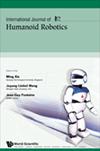Design Principles for Dependable Robotic Assistants
IF 1.6
4区 计算机科学
Q4 ROBOTICS
引用次数: 34
Abstract
A large number of functionalities have been integrated into a single fully autonomous humanoid robot, HERMES. To evaluate the dependability of this extremely complex machine, and its ability to interact with strangers, HERMES was exhibited in a museum, far away from its home laboratory, for more than six months. During this period the robot and its skills were regularly demonstrated to the public by non-expert presenters up to 12 hours per day. Also, HERMES interacted with the visitors, chatted with them in English, French and German, answered questions and performed services as requested by them. Only three major failures occurred during the 6-month period, all of them caused by failures of commercially available modules that could easily be replaced. The key to this success was the dependability that had been originally designed into HERMES. During the design process certain design principles were followed in both hardware and software. These principles are introduced, and some long- and short-term experiments carried out with the real robot in real environments are presented. In fact, by demonstrating HERMES in the museum, at trade fairs and in TV studios — besides our institute environment — we have learned valuable lessons, especially regarding the interaction of a complex robotic assistant with unknown humans. Although we did not quantitatively evaluate the robot’s performance or acceptance by the non-expert users, several qualitative results are given in this paper, and many videos highlighting these results can be downloaded from the HERMES homepage.可靠机器人助手的设计原则
大量的功能已经集成到一个完全自主的人形机器人HERMES中。为了评估这台极其复杂的机器的可靠性,以及它与陌生人互动的能力,HERMES在远离其实验室的博物馆里展出了六个多月。在此期间,机器人和它的技能由非专业的主持人定期向公众展示,每天长达12小时。此外,HERMES还与参观者进行互动,用英语、法语和德语与他们聊天,回答他们的问题,并根据他们的要求提供服务。在6个月的时间里,只发生了三次重大故障,所有这些故障都是由市售模块的故障引起的,这些模块很容易被替换。这一成功的关键在于赫尔墨斯最初设计的可靠性。在设计过程中,硬件和软件都遵循一定的设计原则。介绍了这些原理,并给出了机器人在真实环境中进行的一些长期和短期实验。事实上,通过在博物馆、贸易博览会和电视演播室展示HERMES,除了我们的研究所环境,我们学到了宝贵的经验,特别是关于复杂的机器人助手与未知人类的互动。虽然我们没有定量评估机器人的性能或非专业用户的接受程度,但本文给出了几个定性结果,并且可以从HERMES主页下载许多突出这些结果的视频。
本文章由计算机程序翻译,如有差异,请以英文原文为准。
求助全文
约1分钟内获得全文
求助全文
来源期刊
CiteScore
3.50
自引率
13.30%
发文量
29
审稿时长
6 months
期刊介绍:
The International Journal of Humanoid Robotics (IJHR) covers all subjects on the mind and body of humanoid robots. It is dedicated to advancing new theories, new techniques, and new implementations contributing to the successful achievement of future robots which not only imitate human beings, but also serve human beings. While IJHR encourages the contribution of original papers which are solidly grounded on proven theories or experimental procedures, the journal also encourages the contribution of innovative papers which venture into the new, frontier areas in robotics. Such papers need not necessarily demonstrate, in the early stages of research and development, the full potential of new findings on a physical or virtual robot.
IJHR welcomes original papers in the following categories:
Research papers, which disseminate scientific findings contributing to solving technical issues underlying the development of humanoid robots, or biologically-inspired robots, having multiple functionality related to either physical capabilities (i.e. motion) or mental capabilities (i.e. intelligence)
Review articles, which describe, in non-technical terms, the latest in basic theories, principles, and algorithmic solutions
Short articles (e.g. feature articles and dialogues), which discuss the latest significant achievements and the future trends in robotics R&D
Papers on curriculum development in humanoid robot education
Book reviews.

 求助内容:
求助内容: 应助结果提醒方式:
应助结果提醒方式:


